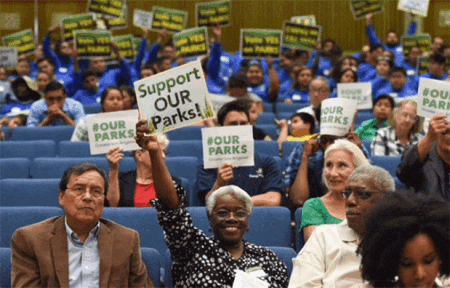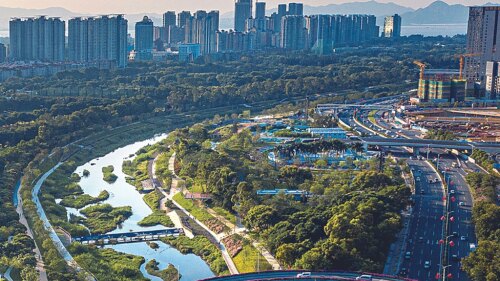In November, voters across the United States endorsed numerous state and local ballot measures approving additional funding for green space, land conservation, and public transportation. Notably, voters also approved minimum-wage increases in four states and legalized medical or recreational marijuana ballot initiatives in eight states.
According to the Center for Transportation Excellence, which follows ballot measures related to public transportation, “November 8 was a historic day for public transportation in the United States as voters approved 34 of 49 public transit measures for an election-day passage rate of 69 percent.” The success rate for transit ballot measures throughout 2016 was 71 percent. In 23 states and communities of all sizes, voters considered nearly $200 billion in local and state support for public transportation.
The largest ballot measures were in California, where San Francisco Bay area voters approved $3.5 billion for the Bay Area Rapid Transit (BART) regional transit system, while Los Angeles voters approved Measure M, a 0.5 percent sales tax increase that will generate an estimated $100 billion over 40 years, including $860 million a year for a big expansion of bus and rail transit.
It wasn’t just in politically progressive California where voters endorsed transit funding. Voters in Atlanta approved $2.5 billion for transit including rail extensions, bus upgrades, and streetcar extensions. Voters also approved an additional $379 million over five years for bike trail and sidewalk improvements.
In Indiana, Indianapolis voters approved a 0.25 percent income tax increase that will fund a regional rapid transit network of expanded bus and bus rapid transit lines, including the next phase of the existing Red Line. Similarly, voters in Raleigh, North Carolina, and Columbus, Ohio, approved ballot measures providing additional funds ($1 billion over ten years for Raleigh) for expanded transit services.
Active transportation including bike trail development and sidewalk improvements also got a boost in several communities, including Atlanta; Portland, Oregon; Charleston, South Carolina; and Maine.
While transit measures received widespread support, park and open space measures received even stronger support. For example, Los Angeles Measure M passed with 70 percent approval, but another proposition, Measure A, passed with an even higher margin, earning nearly 73 percent of the vote. Measure A will boost investments in park space and will accelerate plans to open much of the Los Angeles River to public access for bicycling and outdoor recreation.
According to the Trust for Public Land, which follows state and local ballot measures for land conservation and parks, voters approved 68 of 86 ballot measures, providing $6.3 billion for conservation. Many of these measures involved tax increases or bonds. Will Rogers, president of the Trust for Public Land, said, “Tonight, we saw again that while American voters are divided on many issues, parks and natural areas are an issue that we can agree on. Whether they were voting for ‘red’ or ‘blue’ candidates, voters are ‘green’ when it comes to parks and close-to-home places for outdoor recreation.”
Earlier in 2016, voters approved 14 of 17 land conservation ballot measures, approving an additional $3.3 billion for parks and open space. This means that in 2016, voters endorsed 82 of 103 ballot measures for land conservation, allocating a total of $9.6 billion. Some of the green space initiatives approved by voters include the following:
- In Boston, by a margin of 48 percent, voters opted to join the Massachusetts Community Preservation Act, a statewide program that provides matching funds for local park, open space, historic preservation, and affordable housing projects.
- In Florida, voters in Lee, Alachua, and Brevard counties all gave approval to ballot initiatives providing upwards of $450 million in funding for land conservation and restoration.
- In Colorado, conservation ballot measures were approved in Boulder, Grand, and Pitkin counties.
- In Ohio, voters in four communities including metro Cincinnati and Columbus overwhelmingly approved new funding for parks.
- In New Jersey, voters in 13 of 16 towns or counties approved property tax increases for parks, open space, and farmland protection.
- Even in deep-red Alabama, voters overwhelmingly (80 percent to 20 percent) endorsed a constitutional amendment that prohibits the state from reallocating state park funds for other purposes.
The high approval rate (79 percent) for land conservation ballot measures is not surprising given the fact that over the last 25-plus years, 75 percent of all state and local ballot measures for conservation have also been approved. Since the Trust for Public Land started tracking ballot measures on land conservation in 1988, voters have approved nearly 2,000 ballot measures allocating more $75 billion for parks and open space.
ULI members should pay particular attention to measures supporting transit and parks because both are key drivers of real estate investment and community revitalization. In 2014, when the Institute surveyed industry leaders and public officials on infrastructure’s role in shaping the competitive city, “infrastructure quality” emerged as the top factor driving where real estate development happens. What’s more, “upgrades to public transit systems”—including bus and fixed-rail systems—emerged as the top infrastructure funding priority. Transit- and park-oriented development have both emerged as major forces shaping the cities of the future.
Edward T. McMahon holds the Charles E. Fraser Chair on Sustainable Development and Environmental Policy at the Urban Land Institute in Washington, D.C.






